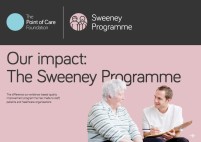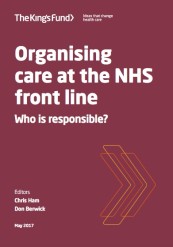Patient experience for healthcare providers
Key points about patient experiences
- This page contains information about patient experiences for healthcare providers.
- Find information on patient experiences, why it's important to learn about it and useful tools and resources to assist you with exploring this concept further.

Video: Defining the Patient Experience
Like many key areas, there are multiple definitions and interpretations of what patient experience is.
A simple definition from the Free Dictionary is: How the patient feels/felt, i.e., good or bad, as/after he or she undergoes/-went an episode of care.
(The Beryl Institute, 2011)
The Beryl Institute define patient experience as: The sum of all interactions, shaped by an organization's culture, that influence patient perceptions across the continuum of care.
They conducted an extensive literature review between 2000-2014 and identified some key concepts. (1)
- "First, the patient experience reflects occurrences and events that happen independently and collectively across the continuum of care. To understand it one need to "move beyond results from surveys,..such as ‘patient satisfaction,’ because patient experience is more than satisfaction alone."
- Embedded within patient experience is a focus on individualized care and tailoring of services to meet patient needs and engage them as partners in their care.
- The patient experience is strongly tied to patients’ expectations and whether they were positively realized (beyond clinical outcomes or health status).
- Finally, the patient experience is integrally tied to the principles and practice of patient and family-centred care.
The Institute for Healthcare Improvement(external link) identified five primary drivers of exceptional patient and family inpatient hospital experience of care:
- leadership
- staff hearts and minds
- respectful partnership
- reliable care
- evidence-based care.
Patient’s care experience includes:
- respect
- partnership
- shared decision making
- well-coordinated transitions and
- efficiency.
Video: All voices matter in patient experience
(The Beryl Institute, 2015)
Since the Quality Chasm Report by the Insitute of Medicine in 2001, patient experience has been increasingly recognised as one of the "three pillars of quality in healthcare alongside clinical effectiveness and patient safety." (2)
A systematic review in 2013 by Doyle et al (3) summarises evidence from 55 studies, finding there was consistent positive associations between:
- patient experience, patient safety and clinical effectiveness for a wide range of disease areas, settings, outcome measures and study designs.
- It demonstrates positive associations between patient experience and self-rated and objectively measured health outcomes;
- adherence to recommended clinical practice and medication;
- preventive care (such as health-promoting behaviour, use of screening services and immunisation); and
- resource use (such as hospitalisation, length of stay and primary-care visits).
A video highlighting the importance of 'how we communicate' and the difference this can make to the patients and clients we care for. Watch the video here(external link).
Dr Kyle Eggleton - Webinar: Practical tips and tools to improve patient experience. Watch the video here(external link).
Video: Patient experience: Brian Boyle's story
Brian Boyle is a National healthcare and patient advocate, published author and public speaker. In this video Brian shared his experience of being a former intensive care patient with various healthcare providers, patient safety directors, and frontline staff. His message focused on showing his appreciation to healthcare providers, offering insight regarding patient safety, quality of care, and the perspective of the patient. Read more at the Brian Boyle website(external link).
(Keynote presentation abridged version, Patient Safety Summit, 2011)
Video: Say This, Not That: Patient Experience
When you need healthcare or emergency services, the experience can be confusing and intimidating for many people. This video shows how "it is not what you say, but how you say it" that can really impact communication and a patient and family's experience of that event. Positive or negative, this impact can have long-standing consequences. "Providing patient care that means more and confuses less, can be as simple as knowing the right thing to say or not to say."
(EIRMC, 2013)
Transforming patient experience – the essential guide
Developed by the NHS Institute for Innovation and Improvement, this guide has some useful resources. While the Institute has closed, some of the resources can still be accessed.
- Slideshow summary(external link)
- Start with the patient – understanding what matters to patients
- Making the case for improving patient experience
- The importance of organisational culture
- The policy framework
- How to improve patient experience – the critical list
- Commissioning for a positive patient experience
- Helping leaders to improve the patient experience
- How to organise a patient experience improvement programme
- Measuring experience
- Helping staff to improve patient experience
- Access to other resources and network
Evidence and resources from The Point of Care Foundation, UK
| Resources | |

|
Our impact – The Sweeney Programme(external link) The Point of Care Foundation, UK
|

|
Our impact – The Schwartz Rounds programme(external link) The Point of Care Foundation, UK
|

|
Organising care at the NHS frontline — Who is responsible?(external link) The King's Fund, UK, 2017
|
- Wolf, Jason A. PhD; Niederhauser, Victoria DrPH, RN; Marshburn, Dianne PhD, RN, NE-BC; and LaVela, Sherri L. PhD, MPH, MBA (2014) "Defining Patient Experience," Patient Experience Journal: Vol. 1: Iss. 1, Article 3.
- Institute of Medicine. Crossing the quality chasm: a new health system for the 21st century. Washington, DC: National Academy
Press, 2001. - Doyle C, Lennox L, Bell D. A systematic review of evidence on the links between patient experience and clinical safety and effectiveness. BMJ Open 2013;3:e001570 [full article](external link)
Credits: Healthify editorial team. Healthify is brought to you by Health Navigator Charitable Trust.


